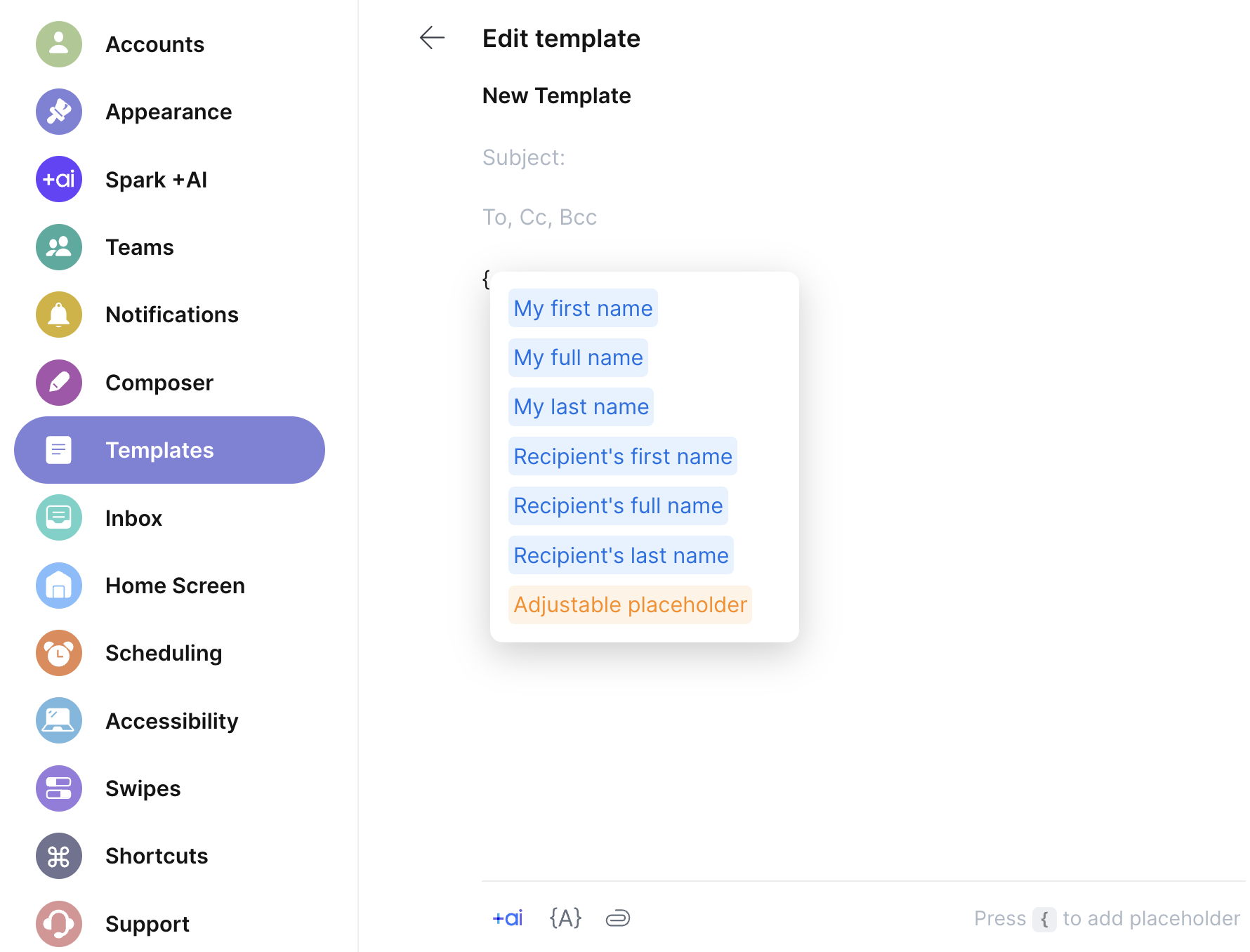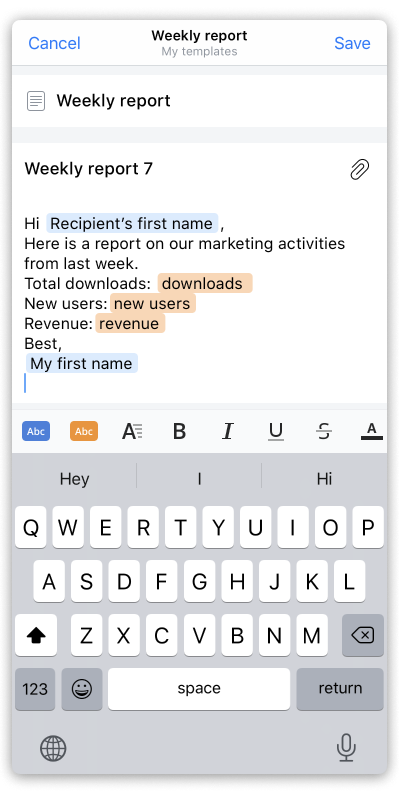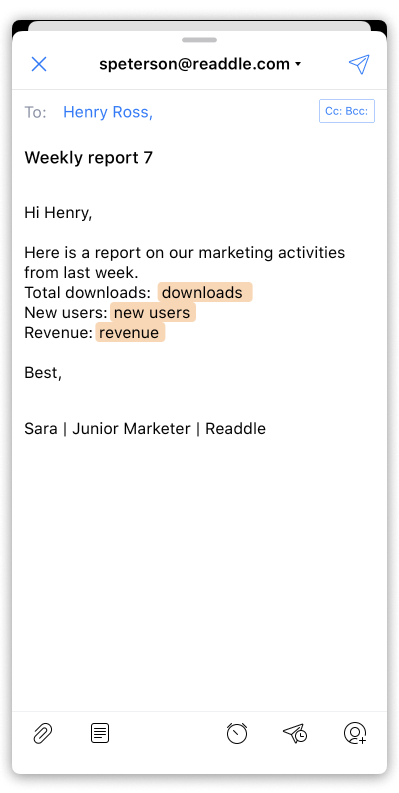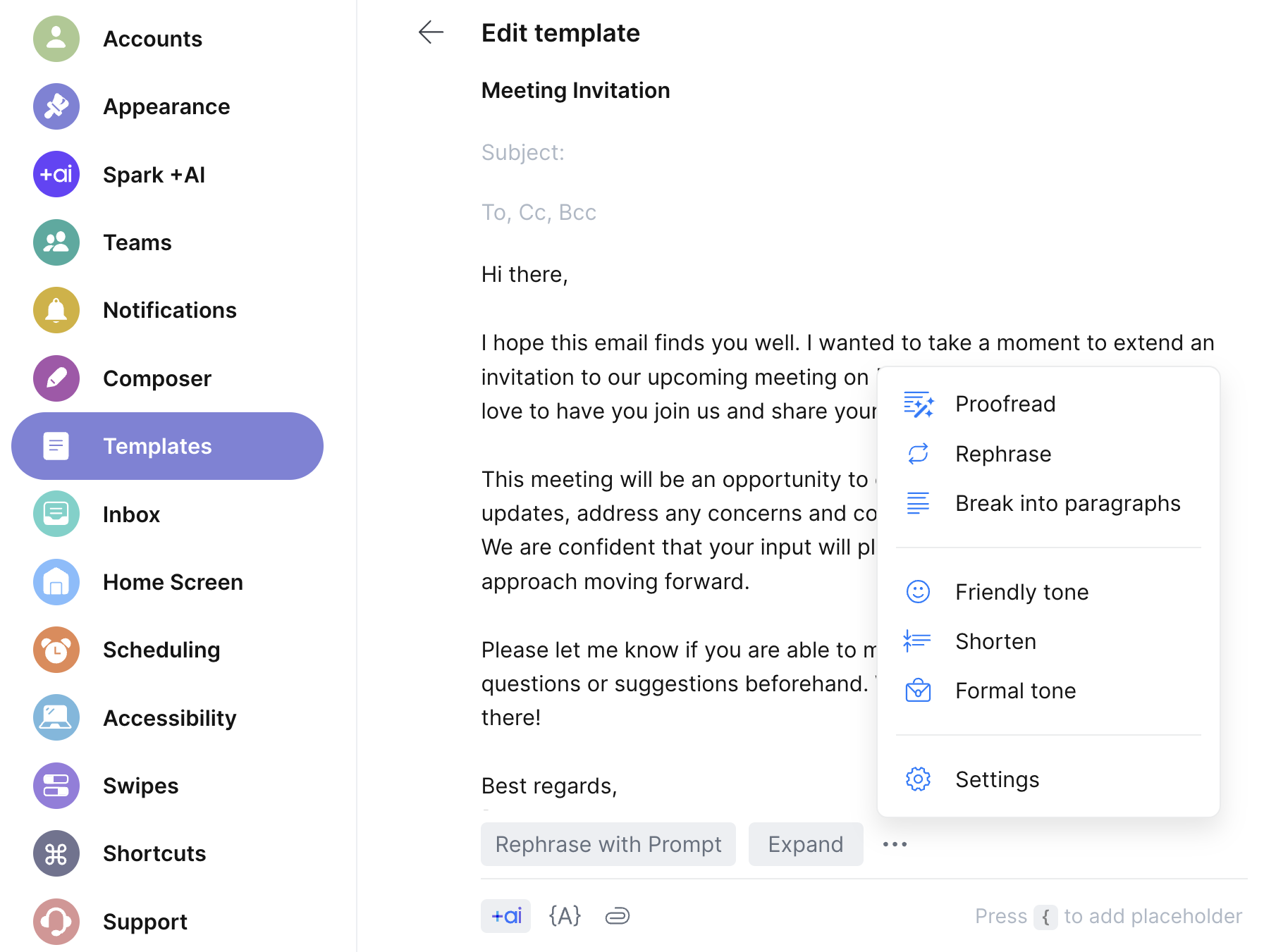In Spark paid plans, you can use email templates to save time when writing similar emails regularly. You can create your own templates for reports, pitches, guides, updates, etc. When composing an email, choose the needed template, and Spark adds the recipient's name or highlights the places you need to modify for this specific recipient.
Jump to:
Create a template
- Open Spark Settings.
- Templates > Add.
- In the New Template field, write the name of your template. The name displays only in Spark and helps you search through your templates.
- Fill in the Subject field.
- Fill in the To, CC, and BCC fields if needed.
- Write the template Text.
- If you want to add a file or an image to your template, click
 at the bottom toolbar or press ⌘ Shift A.
at the bottom toolbar or press ⌘ Shift A. - Use placeholders for your and your recipient's names. Spark automatically fills them out based on the information in the To: and From fields when you compose an email. Place the cursor wherever you want to insert a name, Press { or click {A} Add a placeholder on the toolbar and choose the needed one from the list.
- You can add an adjustable placeholder to fill out manually when sending an email. For example, you may create a placeholder for the actual numbers in your weekly report. Click the Adjustable placeholder and type its name.

- Open Spark Settings.
- Templates > Add.
- In the New Template field, write the name of your template. The name displays only in Spark and helps you search through your templates.
- Fill in the Subject field.
- Fill in the To, CC, and BCC fields if needed.
- Write the template Text.
- If you want to add a file or an image to your template, click
 at the bottom toolbar or press Ctrl Shift A.
at the bottom toolbar or press Ctrl Shift A. - Use placeholders for your and your recipient's names. Spark automatically fills them out based on the information in the To: and From fields when you compose an email. Place the cursor wherever you want to insert a name, Press { or click {A} Add a placeholder on the toolbar and choose the needed one from the list.
- You can add an adjustable placeholder to fill out manually when sending an email. For example, you may create a placeholder for the actual numbers in your weekly report. Click the Adjustable placeholder and type its name.

- Tap the menu icon
 at the top left.
at the top left. - Open Settings > Email Templates.
- Tap Create New Template. If you have a team in Spark, the app asks you where to create a template: In your team’s folder or in your own one.
- Write the name of your template. The name displays only in Spark and helps you search through your templates.
- Fill the Subject field and write the template text.
- If you want to add a file or an image to your template, tap
 .
. - Use placeholders for your and your recipient 's names. Spark automatically fills them out based on the information in the To: and From: fields when you compose an email. Tap the blue placeholder icon
 on the bottom toolbar and choose the needed one from the list.
on the bottom toolbar and choose the needed one from the list. - You can add a custom placeholder to fill out manually when sending an email. For example, you may create a placeholder for the actual numbers in your weekly report. Tap the orange placeholder icon
 and type the placeholder name.
and type the placeholder name. - Once you’ve finished, tap Save at the top right.
- Tap the menu icon
 at the top left.
at the top left. - Open Settings > Email Templates.
- Tap Add Template. If you have a team in Spark, the app asks you where to create a template: In your team’s folder or in your own one.
- Write the name of your template. The name displays only in Spark and helps you search through your templates.
- Fill in the To, CC, and BCC fields if needed.
- Fill the Subject field and write the template text.
- If you want to add a file or an image to your template, tap
 at the bottom right.
at the bottom right. - Use placeholders for your and your recipient 's names. Spark automatically fills them out based on the information in the To: and From: fields when you compose an email. Tap wherever you want to insert a name, tap
 and choose the needed one from the list.
and choose the needed one from the list. - You can add a custom placeholder to fill out manually when sending an email. For example, you may create a placeholder for the actual numbers in your weekly report. Choose
 and type its name.
and type its name. - Once you’ve finished, tap Save at the top right.

Send template
- Click
 at the top right or press Ctrl N.
at the top right or press Ctrl N. - If you didn’t add the recipient’s email address in the To: field, please add it now and before applying a template. Spark uses the To: field information to replace a placeholder with the recipient’s name. Once applied, the template can’t update automatically based on the To: field.
- Click
 and choose a template from the list. To find the template quickly, type its name in the search field.
and choose a template from the list. To find the template quickly, type its name in the search field. - Check the recipient’s name in the email body before sending. Spark can’t replace a placeholder with the correct name if the To: field contains a company’s name or no name. This depends on the settings the recipient has chosen for his or her email account.
- If you have added custom placeholders, you need to fill them with actual data. Click on the placeholder and type your text.
- When you’re finished, click Send. Spark warns you if any of your placeholders are empty.
- Click
 at the top right or press C.
at the top right or press C. - If you didn’t add the recipient’s email address in the To: field, please add it now and before applying a template. Spark uses the To: field information to replace a placeholder with the recipient’s name. Once applied, the template can’t update automatically based on the To: field.
- Click
 and choose a template from the list. To find the template quickly, type its name in the search field.
and choose a template from the list. To find the template quickly, type its name in the search field. - Check the recipient’s name in the email body before sending. Spark can’t replace a placeholder with the correct name if the To: field contains a company’s name or no name. This depends on the settings the recipient has chosen for his or her email account.
- If you have added custom placeholders, you need to fill them with actual data. Click on the placeholder and type your text.
- When you’re finished, click Send. Spark warns you if any of your placeholders are empty.
- Tap
 to create a new email.
to create a new email. - Add the recipient’s email address in the To: field. Please do it before applying a template. Spark uses the information in the To: field to replace a placeholder with the recipient’s name. Once applied, the template can’t update automatically based on the To: field.
- Tap
 at the bottom and choose a template from the list. To find the template quickly, type its name in the search field.
at the bottom and choose a template from the list. To find the template quickly, type its name in the search field. - Check the recipient’s name in the email body before sending. Spark can’t replace a placeholder with the right name if the To: field contains a company’s name or no name at all. This depends on the settings the recipient has chosen for his or her email account.
- If you have added custom placeholders, you need to fill them with actual data. Tap the placeholder and type your text.
- Tap
 at the top right to send an email. Spark warns you if any of your placeholders are empty.
at the top right to send an email. Spark warns you if any of your placeholders are empty.
- Tap
 to create a new email.
to create a new email. - If you didn 't add the recipient’s email address in the To: field, please add it now and before applying a template. Spark uses the information in the To: field to replace a placeholder with the recipient’s name. Once applied, the template can’t update automatically based on the To: field.
- Tap
 at the bottom and choose a template from the list. To find the template quickly, type its name in the search field.
at the bottom and choose a template from the list. To find the template quickly, type its name in the search field. - Check the recipient’s name in the email body before sending. Spark can’t replace a placeholder with the right name if the To: field contains a company’s name or no name at all. This depends on the settings the recipient has chosen for his or her email account.
- If you have added custom placeholders, you need to fill them with actual data. Tap the placeholder and type your text.

- Tap
 at the top right to send an email. Spark warns you if any of your placeholders are empty.
at the top right to send an email. Spark warns you if any of your placeholders are empty.
Copy or delete template
- Open Spark Settings.
- Templates.
- Pleace the cursor on the template you want to modify.
- Select
 Copy or
Copy or  Delete action.
Delete action.
- Open Spark Settings.
- Templates.
- Pleace the cursor on the template you want to modify.
- Select
 Copy or
Copy or  Delete action.
Delete action.
- Tap the menu icon
 at the top left.
at the top left. - Open Settings > Templates.
- Here, you can see the templates you or your teammates have created. You can quickly find the needed template by typing its name in the search field. Tap the template to view or modify it.
- You can copy or move a template to a different folder. For example, you can share your template with your team. Open a template, tap
 at the top right, choose Copy or Move and select your team’s folder.
at the top right, choose Copy or Move and select your team’s folder. - To remove a template, tap
 and choose Delete. Please note: You can’t undo this action!
and choose Delete. Please note: You can’t undo this action!
- Tap the menu icon
 at the top left.
at the top left. - Open Settings > Templates.
- Here, you can see the templates you or your teammates have created. You can quickly find the needed template by typing its name in the search field. Tap the template to view or modify it.
- You can copy or move a template to a different folder. For example, you can share your template with your team. Open a template, tap
 at the top right, choose Copy or Move and select your team’s folder.
at the top right, choose Copy or Move and select your team’s folder. - To remove a template, tap
 and choose Delete. Please note: You can’t undo this action!
and choose Delete. Please note: You can’t undo this action!
Templates +AI
Templates +AI is a part of the Spark +AI suite of tools, available with Spark paid plans.
Use +AI to draft new email templates faster and beat writer’s block. Refine the phrasing, eliminate mistakes, and adjust the tone.
What’s more, when replying to emails, +AI will adapt a template to match incoming email content.
Create template with +AI
- Open Spark Settings.
- Spark +AI > Enable the toggle.
- Go to Templates > Add.
- When adding a template, select between Generate a Draft, Invite to a meeting…, and Make an intro to… +AI options.
- Compose a prompt.
- Fill in the necessary information.
- Open Spark Settings.
- Spark +AI > Enable the toggle.
- Go to Templates > Add.
- When adding a template, select between Generate a Draft, Invite to a meeting…, and Make an intro to… +AI options.
- Compose a prompt.
- Fill in the necessary information.
- Tap the menu icon
 at the top left.
at the top left. - Open Settings > Templates.
- Go to Templates.
- Tap Add. If you have a team in Spark, the app asks you where to create a template: In your team’s folder or in your own one.
- Tap +AI Generate a Template.
- Compose a prompt > Generate.
- Adjust the prompt, if needed.
- Tap +Insert when the text is ready.
- Fill in the necessary information > Save.
- Tap the menu icon
 at the top left.
at the top left. - Open Settings > Email Templates.
- Go to Email Templates.
- Tap Add. If you have a team in Spark, the app asks you where to create a template: In your team’s folder or in your own one.
- Tap +AI Generate a Template.
- Compose a prompt > Generate.
- Adjust the prompt, if needed.
- Tap +Insert when the text is ready.
- Fill in the necessary information > Save.
Edit template with +AI
- Open Spark Settings.
- Templates > Select a template you want to edit.
- Select +AI option.

- Open Spark Settings.
- Templates > Select a template you want to edit.
- Select +AI option.

- Tap the menu icon
 at the top left.
at the top left. - Open Settings > Templates.
- Tap on the template you want to Edit.
- Tap on the +AI button at the bottom right and select the +AI action.
- Tap the menu icon
 at the top left.
at the top left. - Open Settings > Email Templates.
- Tap on the template you want to Edit.
- Tap on the +AI button at the bottom right and select the +AI action.
Reply with +AI Templates
+AI automatically adapts template to the context of the incoming email, filling in the custom placeholders, updating the recipient's name/product/ company/services/dates, and other info, saving you time.
- Open Spark Settings.
- Spark +AI > Enable the toggle.
- Go to Templates.
- Use +AI to apply templates > Enable the toggle.
- Open an email you want to reply.
- Click
 and choose a template from the list. To find the template quickly, type its name in the search field.
and choose a template from the list. To find the template quickly, type its name in the search field. - +AI will proofread and adapt your template to the context of the incoming email, pre-filling adjustable placeholders (if you have them).
- Open Spark Settings.
- Spark +AI > Enable the toggle.
- Go to Templates.
- Use +AI to apply templates > Enable the toggle.
- Open an email you want to reply.
- Click
 and choose a template from the list. To find the template quickly, type its name in the search field.
and choose a template from the list. To find the template quickly, type its name in the search field. - +AI will proofread and adapt your template to the context of the incoming email, pre-filling adjustable placeholders (if you have them).
- Tap the menu icon
 at the top left.
at the top left. - Open Settings > Spark +AI > Enable the toggle.
- Go to Email Templates.
- Use +AI to apply templates > Enable the toggle.
- Open an email you want to reply.
- Tap Reply
- Tap
 and choose a template from the list. To find the template quickly, type its name in the search field.
and choose a template from the list. To find the template quickly, type its name in the search field. - +AI will proofread and adapt your template to the context of the incoming email, pre-filling adjustable placeholders (if you have them).
- Tap the menu icon
 at the top left.
at the top left. - Open Settings > Spark +AI > Enable the toggle.
- Go to Email Templates.
- Use +AI to apply templates > Enable the toggle.
- Open an email you want to reply.
- Tap Reply.
- Tap
 and choose a template from the list. To find the template quickly, type its name in the search field.
and choose a template from the list. To find the template quickly, type its name in the search field. - +AI will proofread and adapt your template to the context of the incoming email, pre-filling adjustable placeholders (if you have them).